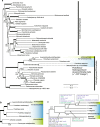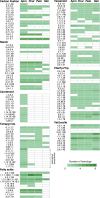Multiple losses of photosynthesis and convergent reductive genome evolution in the colourless green algae Prototheca
- PMID: 29343788
- PMCID: PMC5772498
- DOI: 10.1038/s41598-017-18378-8
Multiple losses of photosynthesis and convergent reductive genome evolution in the colourless green algae Prototheca
Abstract
Autotrophic eukaryotes have evolved by the endosymbiotic uptake of photosynthetic organisms. Interestingly, many algae and plants have secondarily lost the photosynthetic activity despite its great advantages. Prototheca and Helicosporidium are non-photosynthetic green algae possessing colourless plastids. The plastid genomes of Prototheca wickerhamii and Helicosporidium sp. are highly reduced owing to the elimination of genes related to photosynthesis. To gain further insight into the reductive genome evolution during the shift from a photosynthetic to a heterotrophic lifestyle, we sequenced the plastid and nuclear genomes of two Prototheca species, P. cutis JCM 15793 and P. stagnora JCM 9641, and performed comparative genome analyses among trebouxiophytes. Our phylogenetic analyses using plastid- and nucleus-encoded proteins strongly suggest that independent losses of photosynthesis have occurred at least three times in the clade of Prototheca and Helicosporidium. Conserved gene content among these non-photosynthetic lineages suggests that the plastid and nuclear genomes have convergently eliminated a similar set of photosynthesis-related genes. Other than the photosynthetic genes, significant gene loss and gain were not observed in Prototheca compared to its closest photosynthetic relative Auxenochlorella. Although it remains unclear why loss of photosynthesis occurred in Prototheca, the mixotrophic capability of trebouxiophytes likely made it possible to eliminate photosynthesis.
Conflict of interest statement
The authors declare that they have no competing interests.
Figures





References
-
- Krause, K. In Organelle Genetics: Evolution of Organelle Genomes and Gene Expression (ed. Bullerwell, C. E.) 79–103 (Springer-Verlag, 2012), 10.1007/978-3-642-22380-8_4.
-
- Figueroa-Martinez F, Nedelcu AM, Smith DR, Reyes-Prieto A. The plastid genome of Polytoma uvella Is the largest known among colorless algae and plants and reflects contrasting evolutionary paths to nonphotosynthetic lifestyles. Plant Physiol. 2017;173:932–943. doi: 10.1104/pp.16.01628. - DOI - PMC - PubMed
Publication types
MeSH terms
LinkOut - more resources
Full Text Sources
Other Literature Sources
Molecular Biology Databases
Research Materials

